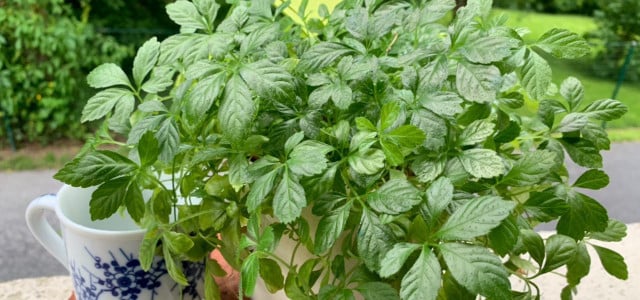
Jiaogulan tea is still quite unknown in Europe. In many parts of Asia, Jiaogulan is considered a valuable medicinal herb. We show you how to prepare the tea and how it works.
Jiaogulan (gynostemma pentaphyllum) is considered one of the ten most important medicinal plants in traditional Chinese medicine. The Asian plant is also called “herb of immortality”. Jiaogulan owes this nickname to a Chinese province in which a striking number of people became over 100 years old. Asked for this, the residents are said to have justified their old age with the consumption of Jiaogulan.
Jiaogulan, like ginseng and Greek mountain tea, belongs to the so -called “adaptogens”. These are biologically active plant substances that are supposed to affect the body and reduce oxidative stress.
Botanically, the plant is one of the pumpkin plants and comes from China, Taiwan, Thailand, Japan and Korea. Because of the leaf shape, Jiaogulan is also called five finger ginseng. In tropical regions, the ranking plant reaches a length of up to nine meters. Jiaogulan also thrives in Europe, but remains significantly smaller due to the climatic conditions. Since the plant is sensitive to frost, it is best to plant it in a saucepan.
Jiaogulan tea: ingredients and effects

The health -promoting effects of Jiaogulan are said to be due to the saponins contained in the plant. These fabrics found cholesterol -lowering, antibiotic and blood pressure -enhancing effects.
The International Journal of Research in Pharmaceutical and Biomedical Sciences has summarized the current state of research and was able to demonstrate the following effects:
-
Antioxidative: Jiaogulan effectively reduces oxidative stress. It helps the body to renew cells and thus slow down the aging process.
-
Antic Cancer: Various studies were able to demonstrate that Jiaogulan has strongly antiquearcinogenic properties. The plant also has a preventive effect and prevents tumors from developing.
-
Adaptogen: Adaptogens support the body’s own regeneration process and help him to deal with negative influences. They have a balancing effect on the hormone balance, blood pressure, blood sugar levels and the immune system.
Note: A large part of the research results come from laboratory studies on mice and other animals. So far, there have been only small clinical studies and not yet sufficient examinations in humans that would show that Jiaogulan or a tea also have the above effects on human health.
Jiaogulan tea: How to prepare him

In Asia, Jiaogulan is considered a food. The leaves are rich in vitamins and nutrients. They are consumed both raw and cooked, for example as a salad, smoothie or similar to spinach.
For medical purposes and with us in Europe, the application as a tea is widespread. So you prepare Jiaogulan tea:
- You can use both fresh and dried leaves for the tea. For one liter you need a teaspoon of the dried herb or about five fresh leaves.
- Cook a liter of water and then let it cool to 90 to 80 degrees.
- Let the tea pull five to ten minutes before you remove the plant parts.
- Traditional Chinese medicine recommends drinking tea every day in the morning and in the evening.
- Women in pregnancy and children can also take tea from Jiaogulan without hesitation.
Due to the EU Novel Food Ordinance, Jiaogulan must not be sold as food or tea in Europe. Due to the regulation, foods that were not sold in Europe until 1997 must be valued before they are approved. Since the approval process is lengthy and expensive and the demand for Jiaogulan is very low, the medicinal plant in Europe is sold as an ornamental plant or nutritional supplements.
Revised by Annika Reketat
Read more on utopia.de:
- Drink tea – but right
- Green tea: effect of the popular tea variety
- Pu-Erh tea: origin, preparation and interesting facts about the fermented tea
** marked with ** or orange underlined Links to sources of supply are partially partner links: If you buy here, you will actively support Techzle\.com, because we will then receive a small part of the sales proceeds. More information.